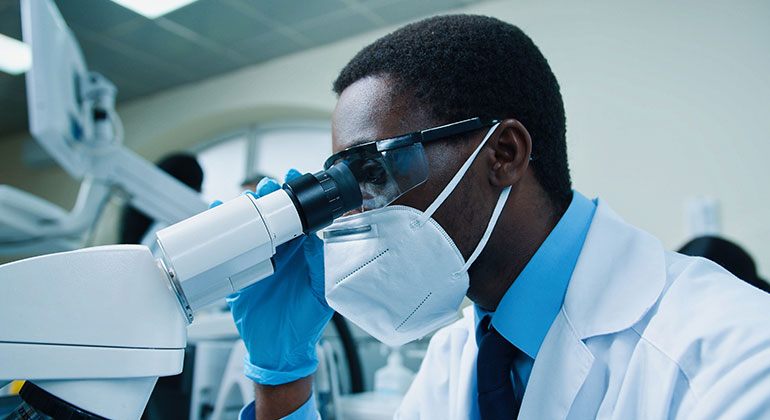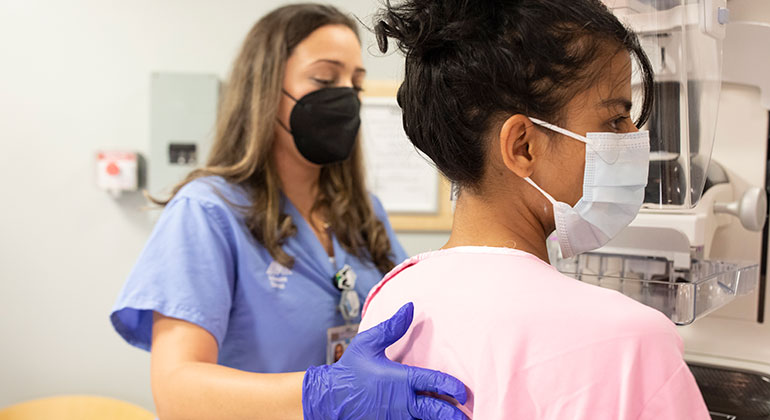International, Multi-Institutional, Women-Led Research Team Receives $900,000 Research Grant from L’Oréal Paris USA and Melanoma Research Alliance to Study Metastatic Melanoma
The Icahn School of Medicine at Mount Sinai is pleased to announce that a global, multi-institutional research team consisting of the Spanish National Cancer Research Centre (CNIO), The Wistar Institute, Cancer Research UK Edinburgh Centre (University of Edinburgh), the Perelman School of Medicine at the University of Pennsylvania, and the Icahn School of Medicine at Mount Sinai has been awarded the L’Oréal Paris USA–MRA Team Science Award for Women in Scientific Research by the Melanoma Research Alliance (MRA), the largest private funder of melanoma research worldwide.
The L’Oréal Paris USA–MRA Team Science Award for Women in Scientific Research recognizes the collaborative efforts by top-notch female investigators whose research focuses on malignant melanoma, a characteristically aggressive cancer type. Increasing in incidence every year, melanoma is the only disease where lesions barely two millimeters thick can disseminate (metastasize) throughout a person’s body. Some patients succumb to metastasis within months, while in others the tumor cells can remain silent or “dormant” for years or decades before striking. This differential in behavior is unclear and is the focus of the collaboration.
Representing Spain, the United States and Scotland, the all-female led team has decided to tackle the mechanisms that distinguish (and mark) fast-growing melanomas from those that are dormant.
“We are thrilled by this L’Oréal Paris USA-MRA grant,” said team leader Maria Soengas at the CNIO. “Visualizing and treating silent melanoma cells has been a major challenge in the field, and therefore requires large collaborative platforms to translate basic results into long-lasting clinical improvements. This partnership will try to bridge this gap by integrating efforts of specialists in molecular biology, tumor dormancy, pathology, and molecular oncology.”
There are four major goals of this three-year project. The first goal of the project is to identify biomarkers of active metastasis. Secondly, the team will define how tumor cells can become “dormant,” and why at some point, they get “awakened.” Both of these studies will utilize sophisticated imaging models to visualize and trace melanoma cells in vivo from early stages of tumor development as well as reagents accessible by the entire team, particularly a large set of clinical specimens. The third goal aims to validate treatments that could attack both dividing and silent melanoma cells. The fourth objective is to mentor and empower new female researchers in the melanoma field.
In 2016, the MRA has funded 17 additional grants to support a total of 46 investigators in 30 institutions spanning seven countries. To date, MRA has dedicated more than $79 million to foster important discoveries across the globe to better understand and treat malignant melanoma.
Since 2013, L’Oréal Paris USA has donated $750,000 to MRA to support the fight to prevent melanoma. For the next three years, L’Oréal Paris USA will continue supporting MRA by donating $250,000 per year. More information can be found at www.ItsThatWorthIt.org.
Research Review
Maria S. (Marisol) Soengas, Ph.D., is the head of the Melanoma Group and the dean for Academic Affairs at the CNIO, and serves as the lead investigator on this project. Research from her group focuses on oncogenic drivers and tumor suppressors that may serve as targets for rational drug design (with papers in Nature Cell Biology, Science and Nature, among others). Soengas actively participates in national and international panels to address and overcome the gender imbalance in science.
“MRA is an example of nonprofit foundations that make us proud in the melanoma community,” said Soengas. “They assemble rigorous evaluation panels to select projects strictly on the basis of scientific merit and clinical relevance. Their partnership with L’Oréal Paris to encourage female scientists to assemble and lead competitive teams further raises their impact on our field. They have our respect and gratitude.”
Ashani Weeraratna, Ph.D., is an associate professor in the Tumor Microenvironment and Metastasis Program at The Wistar Institute and member of The Wistar Institute Melanoma Center, in Philadelphia, PA. Weeraratna has a long history of publication in the area of melanoma metastasis, with particular expertise in Wnt signaling. Recently, her work has expanded to study the role of the aged microenvironment in promoting both metastasis and resistance (Nature, 2016). Weeraratna is the founder and chair of the Women In Science Lecture Series at the Society for Melanoma Research (SMR) meetings and is an active mentor for young women scientists.
“This grant demonstrates the catalyzing effect research across institutes and continents brings to pushing the envelope forward on breakthroughs in melanoma diagnosis and treatment,” Weeraratna said. “It is also a bold statement about L’Oréal Paris’s and MRA’s shared commitment to the innovative high-caliber work female scientists bring to cancer research and discovery, which will inspire many more young women to attain jobs in science.”
E. Elizabeth Patton, Ph.D., is a program leader within the MRC Institute of Genetics and Molecular Medicine at the University of Edinburgh, in the United Kingdom. Patton is an expert in melanocyte and melanoma genetics and development in zebrafish, with a special focus on innovative chemical biology (e.g. Current Biology, Development, Chemistry & Biology, Developmental Cell, Journal of Investigative Dermatology, Nature Communications). Patton has recently established the BBSRC-funded Zebrafish UK High-Throughput Small Molecule Screening Centre and is recipient of a European Research Council Consolidator Award. Patton participated at the SMR Women in Science panel and, with Soengas, has coauthored an editorial for the Pigment Cell & Melanoma Research Journal on proactive measures to promote the advancement of female scientists.
“Melanoma remains the deadliest form of skin cancer, but opportunities to work as a collaborative team means a critical mass in melanoma research and the chance to make important research strides and ultimately save lives,” said Patton.
Lynn M. Schuchter, M.D., is chief of the division of Hematology/Oncology at the Perelman School of Medicine at the University of Pennsylvania and program leader for the Abramson Cancer Center’s NCI-approved Melanoma Research Program, in Philadelphia, PA. She is the co-principal investigator of a highly competitive Specialized Programs of Research Excellence (SPORE) cancer project in the United States, and is the current chair of the American Society of Clinical Oncology’s Cancer Research Committee. Schuchter trains physicians and scientists interested in translational and clinical oncology research and is an active mentor of junior faculty.
“Collaboration is at the crux of scientific research today because one needs to bring together people with unique and varied know-how and resources to make distinctive contributions,” Schuchter said. “The L’Oréal Paris and MRA grant epitomizes what research should allow us to do—exchange knowledge, enact ambitious science and empower women to pursue cutting edge jobs in science.”
Maria Soledad Sosa, Ph.D., has been recently appointed as an assistant professor at Mount Sinai Department of Medicine, in New York, N.Y. She trained in the field of proteomics in melanoma and is an expert in tumor dormancy (Nature Medicine, 2013; Nature Reviews Cancer, 2014). She has identified novel mechanisms that control proliferation and quiescence of residual disease (Nature Communications, 2015). Sosa will perform comparative analyses of dormancy signatures among aggressive tumors. This project allows her to set up new collaborations and networks that will ultimately solidify her career and international relevance.
“This grant has enabled me to work with leading scientists in the field of melanoma research and gain valuable experience working at the forefront of an exciting, rigorous field,” Sosa said. “As a young researcher in the early stages of my career, I couldn’t ask for a better experience.”
Melanoma Research Alliance
MRA is a public charity formed in 2007 under the auspices of the Milken Institute, with the generous founding support of Debra and Leon Black. MRA is the largest private funder of melanoma research and has provided more than $79 million to research seeking to better prevent, diagnose, and treat melanoma, the deadliest type of skin cancer. Due to the ongoing support of its founders, 100 percent of every dollar MRA raises goes to support its melanoma research program. MRA’s ability to fund wideranging research in melanoma is amplified by unique collaborations and partnerships with individuals, private foundations, and corporations. Visit www.CureMelanoma.org for more information.
L’Oréal Paris
The L’Oréal Paris division of L’Oréal USA, Inc. is a total beauty care brand dedicated to empowering women by offering the most luxurious and innovative products and services available in the mass market. The brand’s signature tagline, “Because I’m Worth It,” was born in the United States in 1971 to celebrate the beauty and intrinsic self-worth of women, and for more than 100 years, L’Oréal Paris has been providing women around the world with products in four major beauty categories: hair color, haircare, skincare and cosmetics. With L’Oréal’s invention of hair color in 1909, the brand continues to serve as the leading innovator of hair products across color, care, and styling with brands such as Superior Preference, Féria, Excellence Crème, Advanced Haircare, Advanced Hairstyle, Elnett Satin Hairspray, the Ever collection, and Oleo Therapy. As the #1 skin expert brand worldwide, L’Oréal Paris provides scientifically-advanced skincare products that are developed to address individual skin concerns through its renowned brands Revitalift, Age Perfect, and Sublime Bronze. In 2014, L’Oréal Paris changed the way women interact with makeup by introducing Makeup Genius, an app that allows users to scan a L’Oréal Paris product or advertisement to virtually try on individual products or curated looks. L’Oréal Paris’ iconic cosmetics collections include Infallible, True Match, Colour Riche, Voluminous, and Visible Lift. For more information about L’Oréal Paris and to receive personalized advice, expert tips, and exclusive content, please visit www.lorealparisusa.com or follow on Instagram (@LOrealMakeup), Snapchat (@LOrealMakeup), Twitter (@LOrealParisUSA), Facebook (@LOrealParisUSA), and Pinterest (@LOrealParisUS)
Spanish National Cancer Research Centre
The Spanish National Cancer Research Centre (CNIO) is a Spanish public institution dedicated to research into the prevention, diagnosis, and treatment of cancer. As one of the world’s leading Cancer Centres (SCImago 2015), the CNIO covers research across the entire R&D&I spectrum by integrating both basic and translational research; thereby ensuring that its scientific discoveries reach the National Health System quickly and efficiently, as well as the pharmaceutical & biotech industry. In the past years, the CNIO has launched two spin‐off companies: Life Length, focused on marketing in-house-developed technology for telomere length determination as a novel method of disease risk prediction; and BioncoTech, which develops a new treatment for highly aggressive melanoma.
For more information, please visit www.cnio.es/@CNIO_Cancer
The Wistar Institute
The Wistar Institute is an international leader in biomedical research with special expertise in cancer research and vaccine development. Founded in 1892 as the first independent nonprofit biomedical research institute in the U.S., Wistar has held the prestigious Cancer Center designation from the National Cancer Institute since 1972. The Institute works actively to ensure that research advances move from the laboratory to the clinic as quickly as possible. wistar.org.
Institute of Genetics & Molecular Medicine
The MRC Institute of Genetics and Molecular Medicine at the University of Edinburgh (IGMM) is based on the Western General Hospital Campus in Edinburgh, Scotland.
The IGMM constitutes one of the largest aggregates of human molecular genetics research capacity in the UK, bringing together over 500 researchers in a single, scientific endeavour.
By pooling the resources and complementary skills of the three partner centres and units of the Institute - the MRC Human Genetics Unit (MRC HGU), the Centre for Genomic and Experimental Medicine (CGEM) and the Edinburgh Cancer Research Centre (ECRC) - the IGMM brings together distinct expertise that maximises scientific discovery and translation of science.
The IGMM aims to identify the molecular and cellular mechanisms underlying normal human development, maintenance and disease, and to translate these findings for clinical benefit.
Penn Medicine
Penn Medicine is one of the world’s leading academic medical centers, dedicated to the related missions of medical education, biomedical research, and excellence in patient care. Penn Medicine consists of the Raymond and Ruth Perelman School of Medicine at the University of Pennsylvania (founded in 1765 as the nation’s first medical school) and the University of Pennsylvania Health System, which together form a $5.3 billion enterprise.
The Perelman School of Medicine has been ranked among the top five medical schools in the United States for the past 18 years, according to U.S. News & World Report's survey of research-oriented medical schools. The School is consistently among the nation's top recipients of funding from the National Institutes of Health, with $373 million awarded in the 2015 fiscal year.
The University of Pennsylvania Health System's patient care facilities include: The Hospital of the University of Pennsylvania and Penn Presbyterian Medical Center -- which are recognized as one of the nation's top "Honor Roll" hospitals by U.S. News & World Report -- Chester County Hospital; Lancaster General Health; Penn Wissahickon Hospice; and Pennsylvania Hospital -- the nation's first hospital, founded in 1751. Additional affiliated inpatient care facilities and services throughout the Philadelphia region include Chestnut Hill Hospital and Good Shepherd Penn Partners, a partnership between Good Shepherd Rehabilitation Network and Penn Medicine.
Penn Medicine is committed to improving lives and health through a variety of community-based programs and activities. In fiscal year 2015, Penn Medicine provided $253.3 million to benefit our community.
Mount Sinai Health System
The Mount Sinai Health System is an integrated health system committed to providing distinguished care, conducting transformative research, and advancing biomedical education. Structured around seven hospital campuses and a single medical school, the Health System has an extensive ambulatory network and a range of inpatient and outpatient services—from community-based facilities to tertiary and quaternary care.
The System includes approximately 7,000 primary and specialty care physicians; 12 joint-venture ambulatory surgery centers; more than 140 ambulatory practices throughout the five boroughs of New York City, Westchester, Long Island, and Florida; and 31 affiliated community health centers. Physicians are affiliated with the renowned Icahn School of Medicine at Mount Sinai, which is ranked among the highest in the nation in National Institutes of Health funding per investigator. The Mount Sinai Hospital is ranked as one of the nation’s top 10 hospitals in Geriatrics, Cardiology/Heart Surgery, and Gastroenterology, and is in the top 25 in five other specialties in the 2014-2015 “Best Hospitals” issue of U.S. News & World Report. Mount Sinai’s Kravis Children’s Hospital also is ranked in seven out of ten pediatric specialties by U.S. News & World Report. The New York Eye and Ear Infirmary of Mount Sinai is ranked 11th nationally for Ophthalmology, while Mount Sinai Beth Israel is ranked regionally.
# # #
About the Mount Sinai Health System
Mount Sinai Health System is one of the largest academic medical systems in the New York metro area, with more than 43,000 employees working across eight hospitals, over 400 outpatient practices, nearly 300 labs, a school of nursing, and a leading school of medicine and graduate education. Mount Sinai advances health for all people, everywhere, by taking on the most complex health care challenges of our time — discovering and applying new scientific learning and knowledge; developing safer, more effective treatments; educating the next generation of medical leaders and innovators; and supporting local communities by delivering high-quality care to all who need it.
Through the integration of its hospitals, labs, and schools, Mount Sinai offers comprehensive health care solutions from birth through geriatrics, leveraging innovative approaches such as artificial intelligence and informatics while keeping patients’ medical and emotional needs at the center of all treatment. The Health System includes approximately 7,300 primary and specialty care physicians; 13 joint-venture outpatient surgery centers throughout the five boroughs of New York City, Westchester, Long Island, and Florida; and more than 30 affiliated community health centers. We are consistently ranked by U.S. News & World Report's Best Hospitals, receiving high "Honor Roll" status, and are highly ranked: No. 1 in Geriatrics and top 20 in Cardiology/Heart Surgery, Diabetes/Endocrinology, Gastroenterology/GI Surgery, Neurology/Neurosurgery, Orthopedics, Pulmonology/Lung Surgery, Rehabilitation, and Urology. New York Eye and Ear Infirmary of Mount Sinai is ranked No. 12 in Ophthalmology. U.S. News & World Report’s “Best Children’s Hospitals” ranks Mount Sinai Kravis Children's Hospital among the country’s best in several pediatric specialties.
For more information, visit https://www.mountsinai.org or find Mount Sinai on Facebook, Twitter and YouTube.

Scientists Create Most Powerful, Accurate Tool Yet to Research Deadliest Blood Cancer
Apr 18, 2023 View All Press Releases
Study Identifies New Gene That Drives Colon Cancer
Oct 14, 2022 View All Press Releases
Molecular Treatment Is Able to Control Brain Metastasis of Different Tumors
Feb 11, 2022 View All Press Releases
Mount Sinai’s Dubin Breast Center Annual Benefit Raises Over $2.5 Million
Feb 08, 2022 View All Press Releases

